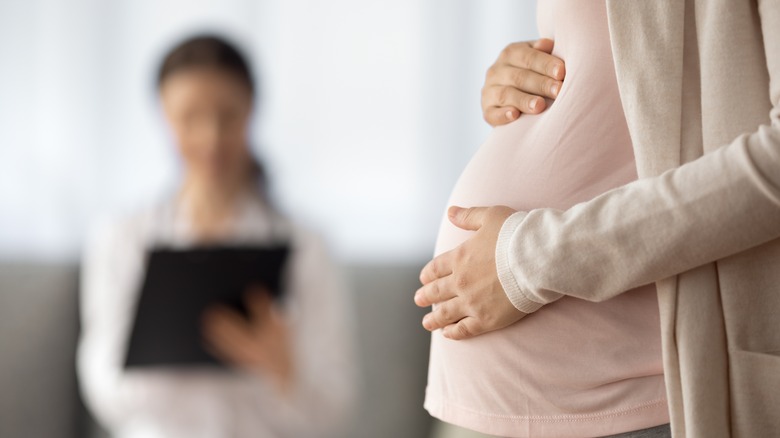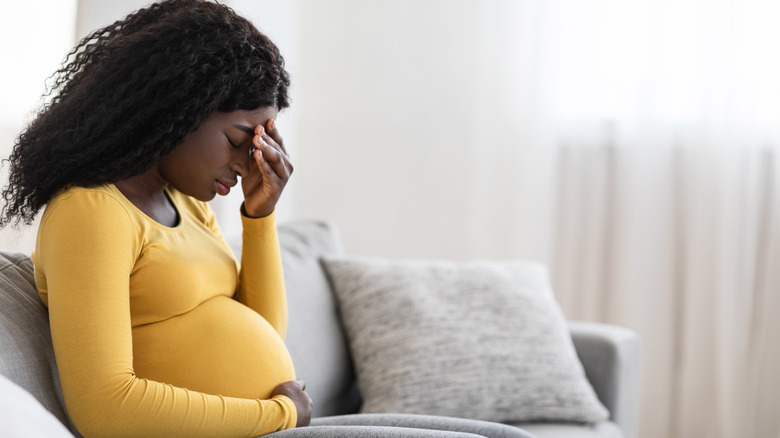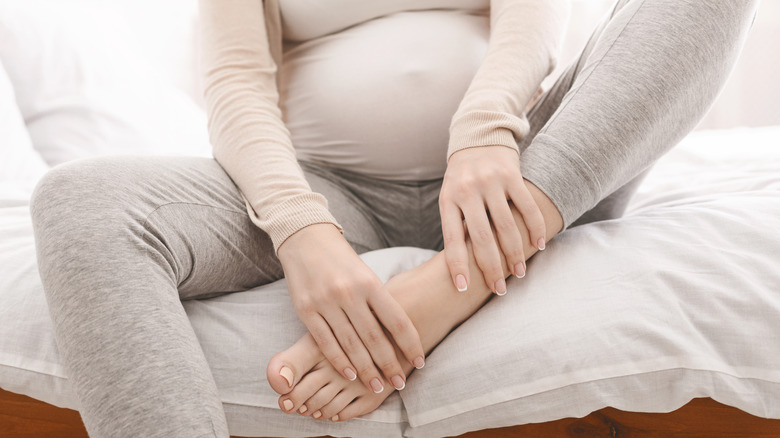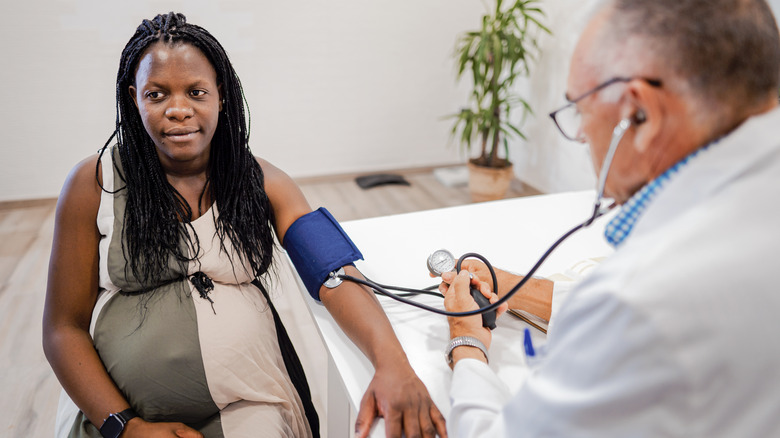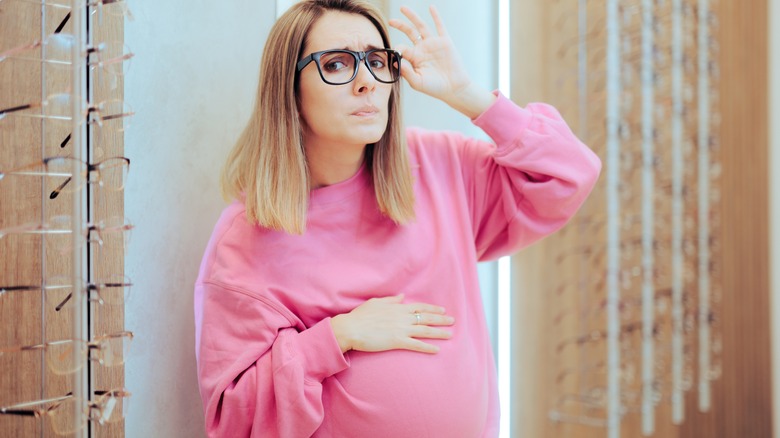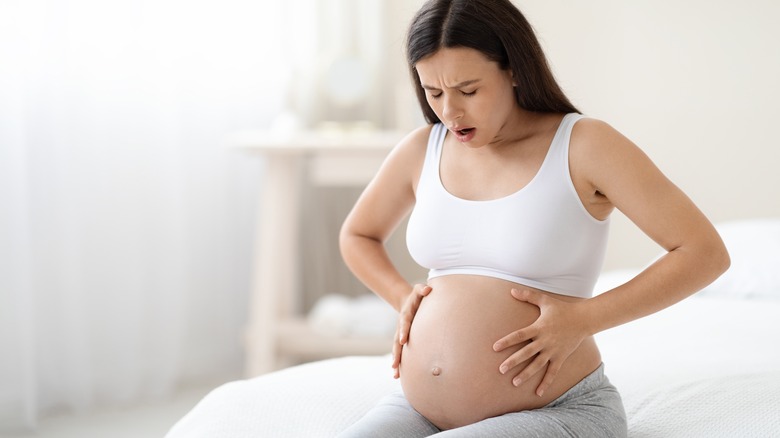5 Signs You Might Have Preeclampsia, According To An OB-GYN
Three-time Olympic medalist Tori Bowie was found dead in her Florida home in early May, when police conducted a wellness check after not hearing from her for several days. The 32-year-old sprinter had been eight months pregnant. Although the Orange County medical examiner's office hasn't determined her official cause of death, an autopsy report said Bowie died of complications from respiratory distress and eclampsia.
Eclampsia occurs during pregnancy and can cause seizures or a coma (via MedlinePlus). Preeclampsia is a pregnancy complication that precedes eclampsia. According to Cleveland Clinic, preeclampsia affects 8% of pregnancies around the world and can require premature childbirth. Preeclampsia can have similar symptoms of a normal pregnancy or not have any symptoms, according to Dr. Stephanie Hack, M.D., the founder of Lady Parts Doctor. Yet certain symptoms can make preeclampsia more noticeable as the condition becomes more severe. In an exclusive interview with Health Digest, Hack tells us the symptoms of severe preeclampsia.
Headache
If you didn't have headaches before you got pregnant, it's common for headaches to accompany the first few months of pregnancy, according to the National Health Service. Headaches should dissipate after the first trimester. Although your OB-GYN might recommend other medications, it's safe to take Tylenol (acetaminophen) for your headaches, according to Mayo Clinic. If you notice headaches starting 20 weeks into your pregnancy, it might be a sign of preeclampsia.
"The preeclampsia headache is a new headache that starts suddenly, doesn't get better with medications, and gets worse over time," Hack said. "It's a sign that preeclampsia is worsening and requires immediate attention. The pain is often described as dull and throbbing and can be one-sided or felt all over."
Some lifestyle changes can help with preeclampsia headaches, such as staying hydrated. It's also important to get enough sleep and find ways to relax, since tension can increase the likelihood of a headache.
Swelling
One of the uncomfortable side effects of pregnancy is swelling. It could be rather frustrating to notice your feet swollen so much that your favorite ankle bracelet (or even shoes) no longer fits. That's because the amounts of water and plasma increase to sustain you and your baby, particularly towards the third trimester (via Healthline). Your sodium levels are also increasing, making you feel like Willy Wonka's Violet Beauregarde.
"Swelling is the result of vascular changes (leaky blood vessels) during pregnancy," Hack said. "Preeclampsia swelling is more excessive than typical pregnancy swelling and may occur more rapidly, leading to rapid weight gain. While swelling of the feet is common in pregnancy, preeclampsia swelling is more likely to involve the hands and face."
According to Healthline, a sign of preeclampsia swelling is how the swelling responds when you press your fingers into it. If there's a dent that remains after pressing into your skin, it could be an indicator of preeclampsia. To help with swelling, prop your feet up each day and avoid long periods of sitting (via Preeclampsia Foundation).
High blood pressure
Stress, being overweight, and a high sodium diet can put you at risk for high blood pressure if you're under 65 (via National Health Service). Other health conditions or medications could also increase your risk of high blood pressure. Having a history of high blood pressure puts you at a greater risk for preeclampsia. If you're healthy and pregnant, you might not recognize high blood pressure because it often doesn't have symptoms. Hack says high blood pressure can be noted in a prenatal visit.
"A newly elevated blood pressure is part of the diagnosis of preeclampsia. Elevated blood pressure consists of a systolic blood pressure of 140 mm Hg or more or diastolic blood pressure of 90 mm Hg or more on two occasions at least 4 hours apart after 20 weeks in a woman with previously normal blood pressure," Hack said. "Once noted, you will likely be asked to complete additional lab work."
Vision changes
Changes in your hormones will often result in changes in your vision in a normal pregnancy, according to the Baby Center. You might notice your eyes becoming a little more dry or irritated, which can affect your vision. Fluid retention in the eye can also make your vision a little blurry. These changes in your vision can occur in your second or third trimester – but they should be minor.
"Visual changes occur in up to 25% of women with preeclampsia with severe features," Hack said. "Blurred vision is the most common visual complaint, but blindspots are also possible." More serious vision changes could be seeing flashing lights, auras, or spots, according to the Preeclampsia Foundation. These changes could mean swelling of the brain, so you should notify your doctor immediately.
Hack says your vision should be back to normal a few weeks after you deliver your baby. Permanent changes to your vision are rare.
Abdominal pain
Pregnancy often comes with harmless abdominal pain related to gas, constipation, or Braxton Hicks contractions. However, more serious abdominal pain could be related to a urinary tract infection, an ectopic pregnancy, or a miscarriage. According to Hack, abdominal pain under your ribs on the right side could also be a sign of liver dysfunction, especially if you have nausea or are vomiting.
The Preeclampsia Foundation says that liver dysfunction might also manifest as lower back or pain in your right shoulder. The pain in your right shoulder could be pain that spreads from the liver. This pain might feel like a hard pinch.
Hack says that any of these symptoms could indicate HELLP syndrome, which is a serious complication of preeclampsia. According to the March of Dimes, HELLP syndrome occurs when you have high levels of liver enzymes, a low blood platelet count, and a breakdown of red blood cells. Although HELLP syndrome is rare, it can be fatal without treatment.

